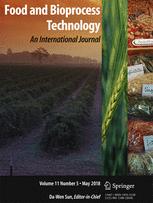Ver ítem
- xmlui.general.dspace_homeCentros e Institutos de InvestigaciónCIA. Centro de Investigaciones de AgroindustriaInstituto de Tecnología de AlimentosArtículos científicosxmlui.ArtifactBrowser.ItemViewer.trail
- Inicio
- Centros e Institutos de Investigación
- CIA. Centro de Investigaciones de Agroindustria
- Instituto de Tecnología de Alimentos
- Artículos científicos
- Ver ítem
Effect of High-Pressure Processing on Quality and Microbiological Properties of a Fermented Beverage Manufactured from Sweet Whey Throughout Refrigerated Storage
Resumen
The production of fermented beverages is a promising way to valorize by-products of dairy manufacturing. However, the shelf-life of these products is often limited by the post-acidification process that occurs during storage. In this work, we manufactured a fermented beverage from sweet whey by using the starter lactic acid bacteria (SLAB) Streptococcus thermophilus and Lactobacillus delbrueckii subsp. bulgaricus. High-pressure processing (HPP) at 200 MPa
[ver mas...]
The production of fermented beverages is a promising way to valorize by-products of dairy manufacturing. However, the shelf-life of these products is often limited by the post-acidification process that occurs during storage. In this work, we manufactured a fermented beverage from sweet whey by using the starter lactic acid bacteria (SLAB) Streptococcus thermophilus and Lactobacillus delbrueckii subsp. bulgaricus. High-pressure processing (HPP) at 200 MPa for 10 min or 400 MPa for 1 min were applied after manufacturing. The aim of this study was to evaluate the effect of HPP on the quality of the beverage and on the behavior of the SLAB. Both high hydrostatic pressure treatments preserved flavor and texture attributes until 45 days post-HPP, without affecting chromatic parameters. Plate counts for both species were lower in HPP-treated beverages (HB) than in control beverages (CB), although treatment at 200 MPa maintained optimal amounts of total SLAB (6.6–7.9 log CFU/mL). Conversely, quantitative PCR (qPCR) and reverse transcription-qPCR (RT-qPCR) revealed that bacterial DNA or mRNA levels persisted after HPP (> 1.4 × 105 genome or cDNA copies/mL), even upon 400-MPa treatments. As a whole, this study indicated that HPP preserved the quality of the beverage until 45 days post-HPP, which is longer than the shelf-life of conventional fermented beverages obtained from milk. Moreover, our results obtained with these SLAB in a fermented dairy beverage upon HPP extend previous findings regarding the limitations of culture-dependent methods to assess microbial viability.
[Cerrar]

Autor
Pega, Juan Franco;
Denoya, Gabriela Inés;
Castells, M.L.;
Sarquis, S.;
Aranibar, G.F.;
Vaudagna, Sergio Ramon;
Nanni, Mariana;
Fuente
Food and bioprocess technology : 1–10. (February 2018)
Fecha
2018-02
ISSN
1935-5130 (Print)
1935-5149 (Online)
1935-5149 (Online)
Formato
pdf
Tipo de documento
artículo
Palabras Claves
Derechos de acceso
Restringido
 Excepto donde se diga explicitamente, este item se publica bajo la siguiente descripción: Creative Commons Attribution-NonCommercial-ShareAlike 2.5 Unported (CC BY-NC-SA 2.5)
Excepto donde se diga explicitamente, este item se publica bajo la siguiente descripción: Creative Commons Attribution-NonCommercial-ShareAlike 2.5 Unported (CC BY-NC-SA 2.5)

